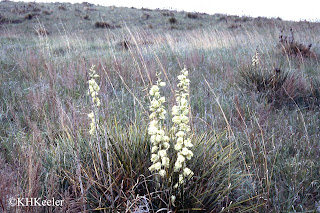 |
| Yucca glauca in flower |
 |
| A young Yucca glauca. You could cover all but the outer tips of the leaves by setting down a pop can. |
Like other yuccas, Y. glauca has a rosette of leaves and can live many years. The plants start as tiny rosettes of short thin leaves and as the plant gets older, the leaves get more numerous and longer.
The leaves are tough and fibrous, with a sharp point at the tip. Cattle generally avoid eating the leaves. Biologists generally avoid walking where the leaves will stab their legs. The evening volleyball game at Cedar Point Biological Station featured the phrase "stucka by a yucca" for players who ran heedlessly after a stray ball into the plants surrounding the improvised volleyball court.
Fibrous leaves with stiff points on the end can be useful. Plains tribes and early settlers carefully peeled back the tip, keeping a long fiber attached, and had an instant needle and thread. The fiber is pretty tough and makes an effective little thread.
 |
| Yucca glauca flowers |
Although yucca leaves are strong and well-defended, Yucca glauca flowers are totally edible. Soft, pleasant and appealing, after washing to remove bugs, they can be eaten raw or cooked, boiled or fried. The deer, elk and pronghorn know that and frequently strip all the flowers off a flower stalk.
Bumping a yucca in flower usually results in several small white moths flying away. Yucca glauca is like other yuccas in being pollinated by a moth who lays her eggs on the developing seeds. She is both a pollinator and a seed-eater. The relationship is long-standing so that the flowers and seeds of yuccas are modified to accomodate this moth. If she doesn't carry pollen between flowers, no seeds are produced because while plant requires pollen from another plant in order to develop seeds, it has no mechanism for getting that pollen unless a yucca moth specifically carries pollen between plants. It has no rewards or attractions for other insects.
The seeds develop in three neat columns. Generally a moth larva eats its way down one column, growing bigger all the time. The female moth may lay eggs on two of the columns of seeds, but never on all three. Obviously, there can be problems if two females target the same flower, but generally they leave scent marks to warn later arrivals to go elsewhere. Since this relationship depends on the plant getting some seeds while feeding the moth, avoidance mechanisms usually work and each yucca flower both feeds one or two moth larvae and develops a column of seeds.
 |
| Yucca glauca roots Compare the drying leaves, top left, to the size of the roots! |
Like most plants of the prairie, soapweed yuccas are deeply rooted. The prairie is a grassland with relatively short plants in part because it is too dry for bigger plants to survive. One mechanism for surviving the periodic droughts of the prairies is having deep or widespread roots that seek water in a large volume of soil. Digging up plants is hard work but sometimes I spotted them at the bottom of eroding banks and road cuts. To the left a big old yucca, showing the massive roots that grow below a modest-sized plant.
 |
| dying yucca; to the right there's a pile of litter from a yucca that died previously. |
Very few people are skilled enough to make fire with an awl these days, and generally prairies are too dry to light fires safely. But if you imagine yourself lost from the wagon train in, say October 1850, having chased the prairie chickens without paying attention to landmarks, a yucca as a source of fuel to start a fire might be very welcome. As I play out this scene in my head, I look around and think, "but, intrepid pioneer, you will also need to find something else to burn or your fire won't last an hour."
 |
| prairie scene |
Prairies are difficult in many ways, not the least the lack of firewood. Got buffalo chips?
A handsome, interesting and useful plant -- soapweed yucca.
Comments and corrections welcome.
Yucca glauca in flower
|
References:
Dunmire, W.W. and G. D. Tierney. 1997. Wild plants and native peoples of the Four Corners. Museum of New Mexico Press, Santa Fe.
Gilmore, M. R. 1919. Uses of plants by the indians of the Missouri River region. Online at Open Library http://archive.org/stream/usesofplantsbyin00gilm#page/n5/mode/2up
Harrington, H.D. 1967. Edible native plants of the Rocky Mountains. University of New Mexico Press, Albuquerque.

This was a great read. Thank you
ReplyDeleteThat was an excellent story about the Yucca Glauca!
ReplyDeleteFantastic Post! Lot of information is helpful in some or the other way. Keep updating yucca roots
ReplyDelete